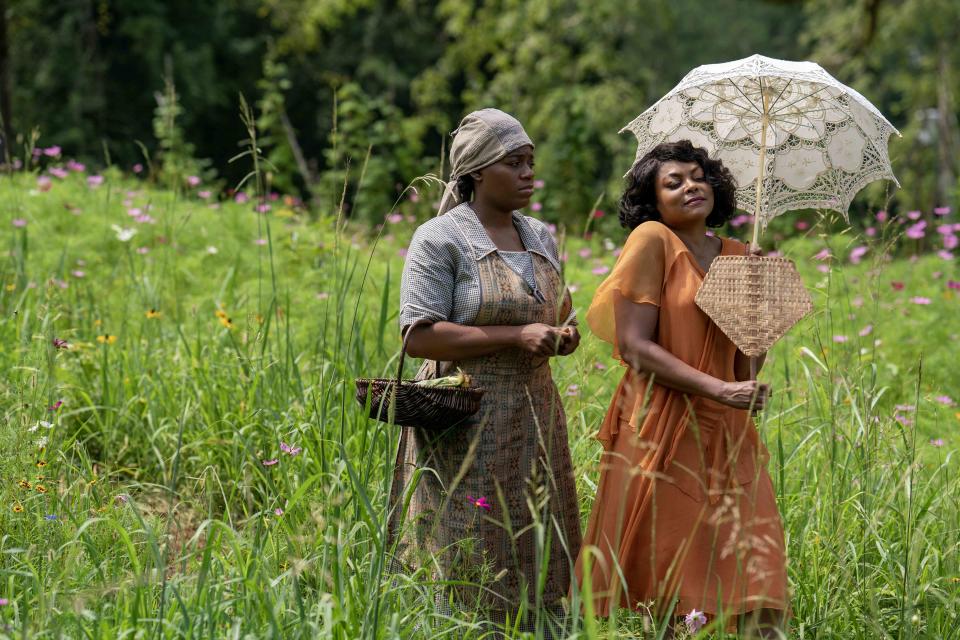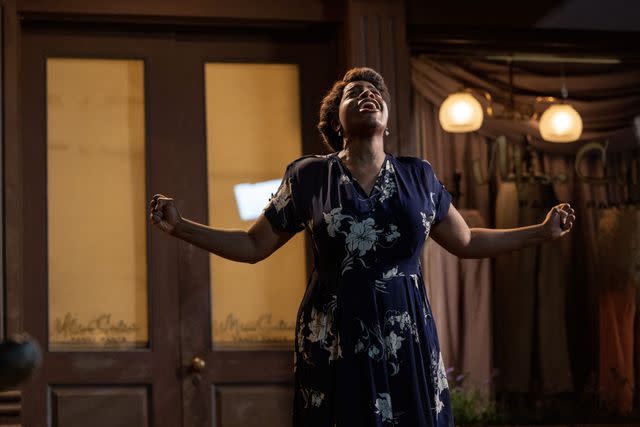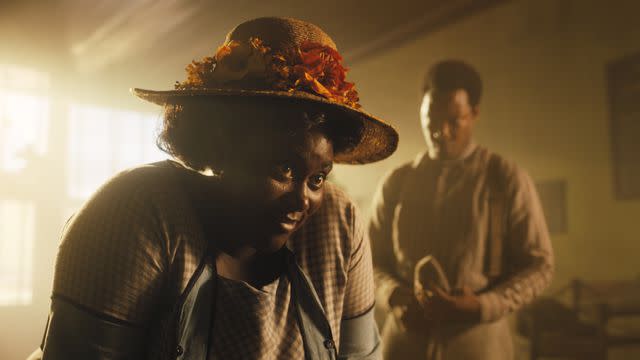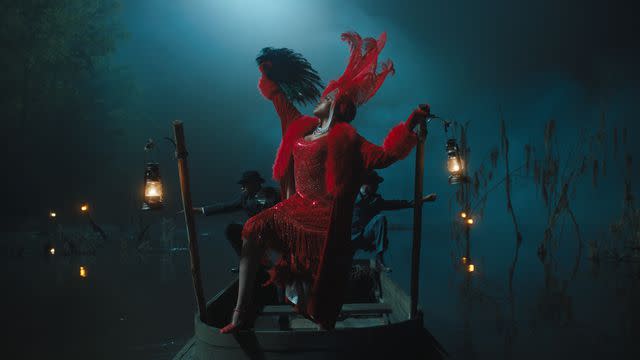'The Color Purple' Has A PG-13 Rating—Is It Ok For Kids?
The movie is based on the musical but still includes some very important themes.

Ser Baffo / Warner Bros. Pictures
Fact checked by Sarah Scott
“I think it pisses God off if you walk by the color purple in a field somewhere and don’t notice it."
I fell in love with The New York Times bestselling book The Color Purple authored by Alice Walker, when I was 14, yet the title has always baffled me. Purple, in all its varied shades, is my favorite color, and it personifies royalty, whimsy, goodness, and depth, in my mind’s eye.
However, when I first read the book as a teen, I didn’t find the glamour that I was searching for. Instead, with its pages, I discovered some hard truths about America’s history, the Deep South, and the generational treatment of women (and sometimes weak-willed men) as a social norm.
But now, as an adult lover of the book, and the original film by Steven Spielberg, I’ve come to learn that “purple” is truly rare, can carry pain, and still represents beauty. Despite the jarring realities of many of the characters within the book, it’s written with such beauty and honesty that the characters have long taken up residency in my mind and heart, as well as the hearts of countless people around the globe.
The novel won the 1983 Pulitzer Prize for Fiction and the National Book Award for Fiction. By 1985, it was adapted into the classic Spielberg film and in 2005, a Broadway musical. Now there's a new movie, but it's not a remake. Instead, it's based on the musical.
The themes and characters within The Color Purple speak to the resiliency of the human spirit in a way that transcends race, gender, and socioeconomic status which is why it's so beloved. In the new film, there are many lessons for older tweens and teens around gender roles, history, sexuality, and even the positive impacts that the arts can have.
There’s an impactful musical theater element throughout the film, and it balances out some of the more intense scenes. The music and the choreography beautifully infuse clues about societal norms and Southern culture. There are fabulous late-night juke joint scenes that showcase jazz, the blues, and swing dance coupled with ornate “church hats” and some of the best millinery designs.
The cinematography and set locations throughout Georgia are very beautiful, and truly give a glimpse of what Southern life from the early 1900s to the 1940s was like. Big front porches, large plantation-size yards, and homes set in the “country’ reflect the life of sharecroppers, farmers, and homeowners who made a living from harvesting crops.
The Themes of 'The Color Purple'
There are many powerful themes within The Color Purple, such as strong female friendships, the benefits of sisterhood, the need for balance when it comes to gender roles within a family structure, the benefits and/or consequences of breaking free from societal norms (as seen in the characters Shug Avery and Sofia), and how history can repeat itself if cycles are not broken.
Both the female and male characters are depicted in extreme juxtaposition to one another, further denoting the need for balance between both genders in a family, but it takes work. The characters are very well-written, and powerful lessons can be learned from the choices they make.

Lynsey Weatherspoon / Warner Bros. Pictures
Celie, the female protagonist, accepts her traditional domesticated duties of cooking, cleaning, and being verbally talked down to by her husband “Mister” who purchased her, and whom she does not love. She’s in search of her identity, insecure, abused, and well-trained to submit, even to a fault.

Warner Bros. Pictures
Sofia, a leading co-star, is a more dominant matriarch in her household. She’s big, bold, unapologetic, and pushes back from taking on all of the household duties. Sofia sets an expectation for her husband, Harpo, to assist with both the children and household duties. She faces hardships in her life, but her fight to show up as herself is a good form of representation for girls of any background to understand that their self-worth is not defined by the shape of their bodies.

Warner Bros. Pictures
Shug Avery, is a jazz singer who has spunk and pizazz. She’s a woman who defies convention altogether. She dates and marries who she wants. She's beautiful, financially independent, well-traveled, and has autonomy over her body and sexuality. Yet, she’s often gossiped about by the people of the town. Ironically, it is through Shug Avery that many women are given agency throughout the film. She personifies freedom and the notion that when you choose to defy the norm, you will be misunderstood.
The characterizations of the men are quite intentional as well. "Mister", a very controlling husband, who sees his wife as his property, perpetuates the same oppressive and sexist attitudes towards Celie, and women in general, that he learned from his father. His learned behavior represents tradition in many respects. Mister relies completely on the women to cook, clean, and take care of the children. While, Harpo, Sofia's husband, is a man who genuinely loves his wife, and is willing to do anything to please her. At times, he’s weak-willed, and he secretly admires his wife’s domineering personality and grit.
Is 'The Color Purple' Appropriate for Kids and Tweens?
While The Color Purple is generally appropriate for ages 13 and up. Parents of all kids should know that it has a PG-13 rating due to some violence, adult language, and some thematic elements.
Sexual innuendos
There may be some questions and conversations with your tweens and teens when it comes to sexual innuendos in the movie.
There’s an adult kiss shared between two women and it’s implied that there were sexual relations. There is also kissing and suggestive dancing between adults, and there are some implied sex scenes between a married couple. It's not shown on screen, but there is a bed shown moving.
Men talk about women suggestively. An adult man tries to take advantage of a young woman, Nettie, who is staying in his home. The difficult topic of rape also comes up. It’s implied that a stepfather tries to rape his stepdaughter, and it’s implied that he rapes his oldest stepdaughter.
Violence
If you or your child is uncomfortable with violence, there is some in this film. There’s a bar brawl where punches are thrown and shots are fired (no one is harmed). There’s some physical violence towards women as indicated above. A woman is also hit in the face with a crowbar by a White man, and then physically beaten by people of the town.
Some strong language and themes
A woman is called “Black, poor, and ugly”, and there’s some adult profanity. Often, women are treated as if they are second-class citizens. Women who defy tradition are at times abused, rejected, or, in some cases, admired. Men are often sexist towards women, and women find strength and comfort in their friendships with other women.
In the end, it's up to parents to decide whether their tween or teen can handle these types of scenes, some difficult themes, and language. But it can also spark conversation between you and your child.
For more Parents news, make sure to sign up for our newsletter!
Read the original article on Parents.

